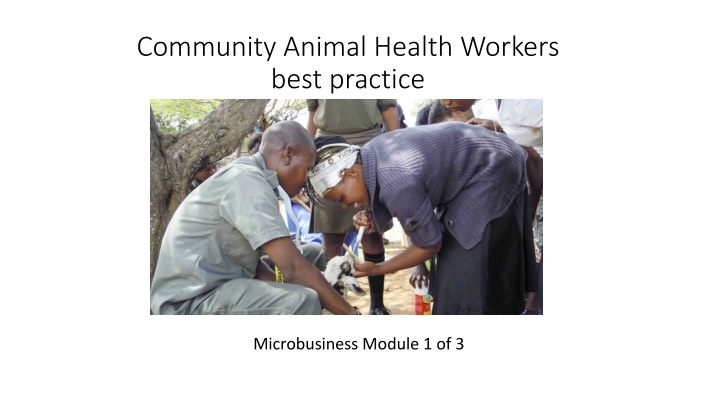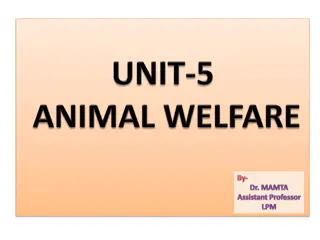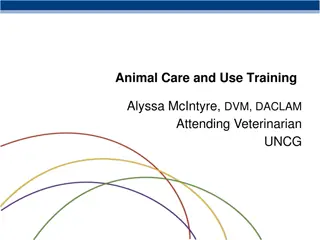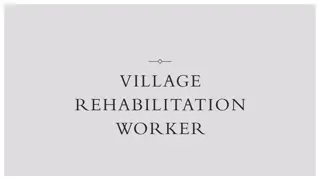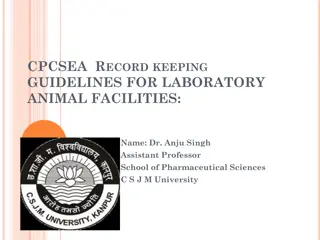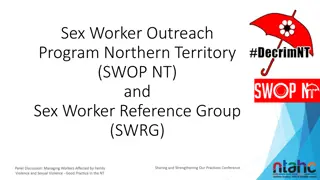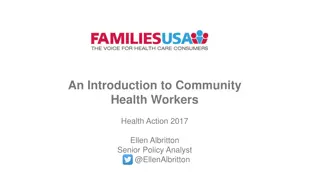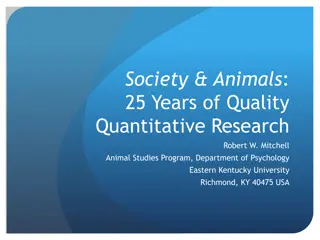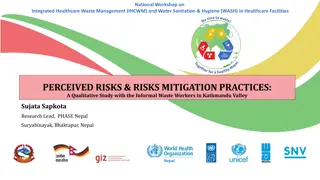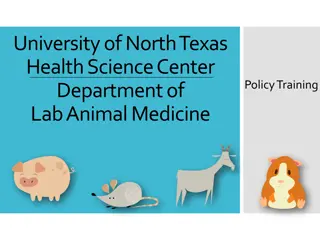Community Animal Health Workers best practice
This module covers the rationale, purpose, and various microbusiness opportunities for Community Animal Health Workers (CAHWs). It emphasizes the need for local intervention due to limited veterinary services in rural areas, proposing a solution through trained CAHWs to support livestock health and productivity. The content outlines selection criteria and key aspects of starting a CAHW program, providing a comprehensive guide for establishing sustainable animal health practices in communities.
Download Presentation

Please find below an Image/Link to download the presentation.
The content on the website is provided AS IS for your information and personal use only. It may not be sold, licensed, or shared on other websites without obtaining consent from the author.If you encounter any issues during the download, it is possible that the publisher has removed the file from their server.
You are allowed to download the files provided on this website for personal or commercial use, subject to the condition that they are used lawfully. All files are the property of their respective owners.
The content on the website is provided AS IS for your information and personal use only. It may not be sold, licensed, or shared on other websites without obtaining consent from the author.
E N D
Presentation Transcript
Community Animal Health Workers best practice Microbusiness Module 1 of 3
Best practices MRDP and Heifer 1. Rationale for a CAHW programme 2. Purpose of a CAHW programme 3. Various CAHW Microbusinesses 4. Starting a CAHW programme 5. CAHW Relationships 6. CAHWs Job Description 7. Training Curriculum and Methodologies 8. Working in Community Groups 9. Vaccination groups 10. Learning through experimentation 11. CAHW training form 12. CAHW Capital Items 13. Costing of Services 14. Livestock Census Form 15. CAHW Treatment Sheet App1 Lists of vet kits References for this module are taken from MRDP Heifer document on CAHW best practice this product is available for free download from www.dukatshani.com www.heifer.org.za
1. Rationale for a CAHW programme State Vets are mandated to deal with controlled diseases and have limited capacity beyond that State vet provides dip for monthly dipping for cattle but there is no provision for goats or chickens or any other animals or any other treatments beyond dipping The cold chain for veterinary medicines into most rural areas is non- existent Farmers do not use medicines regularly enough and in the volumes they can buy them in so you often have half used and expired medicine in farmer s homes. Livestock owners are generally older and less likely to be literate so cannot understand labels or dosages Productivity in rural areas is severely limited by the lack of veterinary interventions around basic animal health
2. Purpose of a CAHW programme Create microbusinesses to support animal health in rural areas Using unemployed youth who are literate and mobile CAHWs support farmers at homestead level in basic animal health Create microbusinesses to support livestock productivity in other ways. For example, blockmaking and winter feed businesses. CAHWs provide a critical link between farmers associations, farmers and the state They can enhance state information campaigns at dip days and on the ground with farmers
3. Various CAHW microbusinesses Basic animal health (training farmers) Para vets (supporting health interventions) Processing foodstuffs (energy blocks, growing winter feeds, processing stover) Skin processing Auctions or sales support Cold chain establishment Agri hubs
4.Starting a CAHW programme Selection Criteria for CAHWs They are selected by the community They are able to read and write in English They are trusted and well known in their community They are currently unemployed They are between 18 and 35 They are interested in livestock and preferably come from a family with livestock They are physically fit and energetic Emphasis towards selecting women Best practice is to facilitate women farmers selecting their own candidate
Starting a CAHW programme Conducting a census A census should give accurate figures of livestock numbers and ownership in the community in which the CAHW will be working Collecting information in communities can often lead to conflict so all community structures need to be informed and be on board. It should provide information on shops that sell medicine in the area and common diseases in the area A census should be seen as a first step in ongoing monitoring of livestock number There needs to be agreement on capturing, using and sharing this information so that it is not used to punish farmers in any way Coalition of this information needs to be planned before the census as it will shape how the census is done and what questions are asked
5. CAHW Relationships Livestock Owners- the CAWHs are trusted. They are understood to be providing a service that needs to be paid for. Livestock Associations- these are their managers. They are the fall back owners for non consumables in the vet kits, hammermills, brickmakers and leather processing equipment. Department of Agriculture- they will help train CAHWs. Will meet monthly at dip tanks and assess their interventions. Will use them for departmental interventions/campaigns. DoA will feed back to livestock associations about specific CAHWs.
CAHW Relationships- cont Private vets- be able to call in private vets on specific and large scale issues that the DoA have been unable to resolve Other role players who need to be consulted and involved Local project leadership Traditional authorities Municipalities Political leadership Agri vet shops Animal Health Product Companies
State Vet Mayor DoA Office Manager of the area Vet Control Technician Start here for CAHW programme Municipal Manager Animal Production Technician Animal Health Technician IDP EXCO Dip Tanks Councillors Livestock Assn Officials
5 cont..So who are the partners and funders Heifer international South Africa and its roles Mdukatshani Rural Development Project and its roles Department of Rural Development (National) its roles Department Agriculture provincially and their roles Sub Departments of Agric Vet/Production and their separate roles Livestock associations and sub bodies
6. CAHWs Job Description Responsible to: Trained by: Coverage area: Working hours: Provision of medicine/vet kit from: How will services be charged: Own transport/charge for transport: Will be given vet kit with the following: This part of the vet kit you will replenish: Ownership of the vet kit: Relationship with state vet: Relationship with the livestock assn: Relationship with DoA Livestock Production Relationship with private vet: Relationship with project executive committee: Relationship with NGO project staff:
CAHWs Job Description- cont Responsibilities Create a baseline of animals in the area Manage livestock registers (annual counting of randomised sample) Give advice regarding medicines and vaccines Bulk buy medicines and sell to farmers Maintain the vet kit for that particular dip Maintain a recording system of treatments, dosage and interventions Keep farmers updated on vaccination calendars and strategic medicinal interventions (e.g. anthrax, blackwater vaccination campaigns) Provide basic animal health care at dip-tank level Assist in disease surveillance (early detection)
CAHWs Job Description- cont Responsibilities Promote Animal identification through tattoos, ear tagging and branding Provide grazing management skills towards feeding during winter bottlenecks Provide support around breeding and selection skills Provide the service of castration and dehorning Mobilize farmers around marketing and value adding Mobilize farmers to provide animals at times of sales or auctions surveillance and reporting of controlled diseases Provide supportive role to Departmental Technicians on dip days and veterinary campaigns Provide theme day trainings at dip days and other gatherings
7. Training Curriculum and Methodologies The training curriculum will be based on the CAHW best practice guide and the three animal health books that have been published For each animal type there will be two days of theory training and at least two days of practice There are three further modules for CAHWs and microbusiness that will require two days each Refresher courses need to be done bi-annually
8. Working in community groups For CAHW to achieve suitability they need to meet regularly with farmers Groups of 15 to 20 farmers Often women work best as they are prepared to learn and change Meet monthly at a farmers home Theme day on a disease or problem farmers are facing from training calenders and book Get ideas of upcoming topic and problems Also present at dips and livestock association
9. Vaccination groups Newcastle common and cheap to fix with monthly vaccination program Members pay R2-R5 each for 2 litres of vaccine that is mixed with them They all bring water and take away vaccine Should see immediate improvement in chickens which gives a good start of relationship with CAHW
10. Learning through experimentation Problems in the area are brought up by farmers and fed back through CAHW to staff Agree on possible interventions through experimenting intervention with farmer Experiment is held in typical farmers yard Experiment is visited by farmers group in x visits Larger farmers days held to show important successes X visits usually walking distance for farmers catering just apples or a snack Farmers days bigger with all farmers in larger area invited and transported- catering usually a meal like lunch and juice
11. CAHW training form CAHW Name _________________________________ Course Date and place and trainer Trained theoretical Duration of course Trainer signature Practical Done at Trainer signature Follow up when General Roles and Responsibilities of CAHW Conducting baselines, routine monitoring and recordkeeping Cost recovery and business management Methodologies Castration Injecting intramuscular and subcutaneous Tattooing Branding Taking and understanding temperature Girth weight belt Famacha Vet kit contents Animal Restraint Basic cold chain principles Diseases Chickens Newcastle disease Fowlpox Gumbora
12. CAHW Capital Items Vet kit handed over after six months of training and practicals. After the handover, the non consumables would revert back to the livestock association if the CAHW wanted to resign All three animal specific vet kits are covered in the training modules 1-4 Depending on funding, a weaning process of the organisation restocking consumables would be agreed with each group but by the end of 4 years the microbusiness will be self sustaining With hammermills and blockmakers, the livestock association would take responsibility for this equipment and would be loaned to to the CAHW who is servicing that area
13.Costing of Services For any service rendered there must be negotiations and agreements around cost of the CAHW getting to the farmer s yard, cost of petrol, medicines or other supplies, and enough profit to make it a viable microbusiness for the CAHW Each of these must be negotiated by project and be known by CAHWs, clients and the association Payment in kind or debts need to discussed and agreed on up front as it can lead to collapse of the CAHW process
14. Livestock Census Form LIVESTOCK CENSUS for area____________ Dip tank/ward and area: ______________________________ Name CAHW/interviewer: ______________________________ Deaths in the last three months Are you are W or M headed household Do you buy animal feed what feed and how much spent this month Do you have your own brand mark Do you use CAHW For what disease or problems Do you vaccinate with/for what Do you have your own medicines- name Do you have own equipment describe it Number and date of interview Surname of kraal/municipal number cattle goats chickens C 1. 2. 3. 4. 5. 6. 7. 8. 9. 10. 11. 12. 13. 14. 15. 16. 17. 18. 19. 20. 21
15.CAHW Treatment Sheet CAHW work sheet CAHW name___________ Area of work ____________ Igama leCAHW: _________________________________________ NGO/Govt official:_________________ Date Name of farmer Identification of animal tattoo etc Type and Weight of animal Famaacha and temperature Treatment or intervention type Type of medicine used Dosage used Dosage cost Total Charged to farmer Cell phone of farmer Farmer signature Total
Non Consumables Prices Digital Thermometer Vacuum flask for vaccinations Syringes- 1 20ml non disposable, 3 10 ml disposable, 2 5 ml disposable Needles- needles for non-disposable syringes (pack of 10/12); needles for disposable 1 box (for goats) Rubber Gloves Face mask Cooler bag for all equipment (6 pack cooler box) Weight belt- cows and goats Stanley knife blades --boxcutters Cotton wool Antiseptic type handwash (bioscrub) Tattoo machine with numbers letters Hoof trimmer Budizzor Pressure sprayer Eye tag applicator and tags
Consumables Prices Antibiotic LA (ultra tet) and normal oxytetrocycline- and sulphur based (Disulphox) Dewormer- Eradiworm, Guardal Liver fluke remedy Wound Spray Tick Grease De-ticking medicines- Dazzel Vitamins- Vitamin 3AD (cattle), Multivitamin Injectable solution- mange, lice (Ivomect or Ecomentic) Terramycin powder (antibiotic powder) Eye powder Karbadust (chickens) Black shoe polish (chickens) Consumix Plus (chickens) Iodine spray Berenil (cattle)
